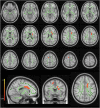Assessing Cerebral White Matter Microstructure in Children With Congenital Sensorineural Hearing Loss: A Tract-Based Spatial Statistics Study
- PMID: 31293368
- PMCID: PMC6598398
- DOI: 10.3389/fnins.2019.00597
Assessing Cerebral White Matter Microstructure in Children With Congenital Sensorineural Hearing Loss: A Tract-Based Spatial Statistics Study
Abstract
Objectives: To assess the microstructural properties of cerebral white matter in children with congenital sensorineural hearing loss (CSNHL).
Methods: Children (>4 years of age) with profound CSNHL and healthy controls with normal hearing (the control group) were enrolled and underwent brain magnetic resonance imaging (MRI) scans with diffusion tensor imaging (DTI). DTI parameters including fractional anisotropy, mean diffusivity, axial diffusivity, and radial diffusivity were obtained from a whole-brain tract-based spatial statistics analysis and were compared between the two groups. In addition, a region of interest (ROI) approach focusing on auditory cortex, i.e., Heschl's gyrus, using visual cortex, i.e., forceps major as an internal control, was performed. Correlations between mean DTI values and age were obtained with the ROI method.
Results: The study cohort consisted of 23 children with CSHNL (11 boys and 12 girls; mean age ± SD: 7.21 ± 2.67 years; range: 4.1-13.5 years) and 18 children in the control group (11 boys and 7 girls; mean age ± SD: 10.86 ± 3.56 years; range: 4.5-15.3 years). We found the axial diffusivity values being significantly greater in the left anterior thalamic radiation, right corticospinal tract, and corpus callosum in the CSHNL group than in the control group (p < 0.05). Significantly higher radial diffusivity values in the white matter tracts were noted in the CSHNL group as compared to the control group (p < 0.05). The fractional anisotropy values in the Heschl's gyrus in the CSNHL group were lower compared to the control group (p = 0.0015). There was significant negative correlation between the mean fractional anisotropy values in Heschl's gyrus and age in the CSNHL group < 7 years of age (r = -0.59, p = 0.004).
Conclusion: Our study showed higher axial and radial diffusivities in the children affected by CNHNL as compared to the hearing children. We also found lower fractional anisotropy values in the Heschl's gyrus in the CSNHL group. Furthermore, we identified negative correlation between the fractional anisotropy values and age up to 7 years in the children born deaf. Our study findings suggest that myelination and axonal structure may be affected due to acoustic deprivation. This information may help to monitor hearing rehabilitation in the deaf children.
Keywords: congenital sensorineural hearing loss; diffusion tensor imaging; diffusivity; magnetic resonance imaging; tract-based spatial statistics; white matter.
Figures





Similar articles
-
Diffusion tensor imaging and MR morphometry of the central auditory pathway and auditory cortex in aging.Neuroscience. 2014 Feb 28;260:87-97. doi: 10.1016/j.neuroscience.2013.12.010. Epub 2013 Dec 13. Neuroscience. 2014. PMID: 24333969
-
Atypical white-matter microstructure in congenitally deaf adults: A region of interest and tractography study using diffusion-tensor imaging.Hear Res. 2017 Jan;343:72-82. doi: 10.1016/j.heares.2016.07.008. Epub 2016 Jul 26. Hear Res. 2017. PMID: 27473505 Free PMC article.
-
Gestational Age at Birth and Brain White Matter Development in Term-Born Infants and Children.AJNR Am J Neuroradiol. 2017 Dec;38(12):2373-2379. doi: 10.3174/ajnr.A5408. Epub 2017 Oct 12. AJNR Am J Neuroradiol. 2017. PMID: 29025726 Free PMC article.
-
The role of diffusion tensor imaging and fractional anisotropy in the evaluation of patients with idiopathic normal pressure hydrocephalus: a literature review.Neurosurg Focus. 2016 Sep;41(3):E12. doi: 10.3171/2016.6.FOCUS16192. Neurosurg Focus. 2016. PMID: 27581308 Review.
-
Diffusion Tensor Imaging of Central Auditory Pathways in Patients with Sensorineural Hearing Loss: A Systematic Review.Otolaryngol Head Neck Surg. 2018 Mar;158(3):432-442. doi: 10.1177/0194599817739838. Epub 2017 Nov 7. Otolaryngol Head Neck Surg. 2018. PMID: 29112481 Free PMC article.
Cited by
-
Quantitative analyses of high-angular resolution diffusion imaging (HARDI)-derived long association fibers in children with sensorineural hearing loss.Int J Dev Neurosci. 2020 Dec;80(8):717-729. doi: 10.1002/jdn.10071. Epub 2020 Oct 31. Int J Dev Neurosci. 2020. PMID: 33067827 Free PMC article.
-
Neural adaptations in short-term learning of sign language revealed by fMRI and DTI.Sci Rep. 2025 Feb 13;15(1):5345. doi: 10.1038/s41598-024-84468-z. Sci Rep. 2025. PMID: 39948087 Free PMC article.
-
Structural neuroimaging of the altered brain stemming from pediatric and adolescent hearing loss-Scientific and clinical challenges.Wiley Interdiscip Rev Syst Biol Med. 2020 Mar;12(2):e1469. doi: 10.1002/wsbm.1469. Epub 2019 Dec 4. Wiley Interdiscip Rev Syst Biol Med. 2020. PMID: 31802640 Free PMC article. Review.
-
Alterations of the cerebral microstructure in patients with noise-induced hearing loss: A diffusion tensor imaging study.Brain Behav. 2024 Apr;14(4):e3479. doi: 10.1002/brb3.3479. Brain Behav. 2024. PMID: 38648388 Free PMC article.
-
Nomogram for prediction of hearing rehabilitation outcome in children with congenital sensorineural hearing loss after cochlear implantation.Heliyon. 2024 Apr 16;10(8):e29529. doi: 10.1016/j.heliyon.2024.e29529. eCollection 2024 Apr 30. Heliyon. 2024. PMID: 38699755 Free PMC article.
References
-
- Andersson J. L., Jenkinson M., Smith S. (2007). Non-Linear Registration, Aka Spatial Normalisation. FMRIB technical report TR07JA2 Oxford: FMRIB Centre.
-
- Basser P. J., Mattiello J., LeBihan D. (1994). Estimation of the effective self-diffusion tensor from the NMR spin echo. J. Magn. Reson. B 103 247–254. - PubMed
LinkOut - more resources
Full Text Sources

